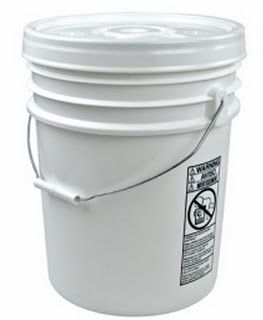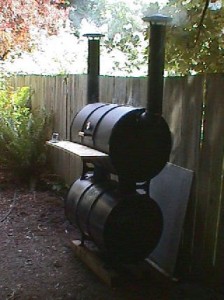Big Baby Double-Barreled Cooker

This design is from the book “Real Barbecue” by Greg Johnson and Vince Staten. Their philosophy with the Big Baby is to take stuff that’s more or less lying around and turn it into a smoker that works on the same principles as the $1,600 models that the pros sell.
The essential function of a top-notch barbecue smoker is to keep the meat entrusted to it comfortably separated from flames and direct heat and yet in the path of the hot air and smoke that give it its flavor. Big Baby does this by burning a hardwood fire in her bottom barrel and using the top barrel to contain the meat and direct the smoke. The top barrel also serves as a big, self-contained drip pan that catches meat juices. And the vents and dampers located all along the air path mean that the fire can be precisely controlled, keeping it from dying or flaring up.
Besides two 55-gallon drums, the “trick” to the smoker is in making use of wood-stove kits designed to convert such drums into cheap stoves for heating storage sheds and such. The kits come with a cast-iron door, cast-iron legs on which to mount the smoker, cast-iron supports to connect the bottom drum to the one above it, plus flues to connect the two drums. From a hardware store or wood-stove shop, you toss in some dampers and a couple of neat little smokestacks for each end to let the smoke escape from the top drum.
Building Big Baby
Before you get started, make sure you have the stuff you’ll need.
The drums you should be able to find for about ten or twenty dollars; the stove kits (it takes two) are available at hardware and wood-stove stores or by mail order from Northern Hydraulics, 801 E. Cliff Rd., P.O. Box 1219, Burnsville, ME 55337, for less than forty or fifty dollars.
The two twenty-two-by-fifteen-inch grill surfaces can be had at a barbecue supply house for twenty-five dollars or so.
Add some bolts, brackets, hinges, smokestacks, fire bricks, paint and such, and you’re up to a total expense of about a hundred and fifty dollars, more than the price of a simple covered grill but considerably less than the cost of a B1 bomber, which, by the way, does a simply horrible job on a rack of ribs.
The steps are simple: Paint the barrels first, then start cutting them with your saber saw. Use a fresh metal-cutting blade (ask the guy at the hardware store or tool rental place for one), and prepare yourself for a violently annoying noise roughly akin to five hundred colicky babies with the croup. Cutting through a hollow drum with a buzzing saber saw makes enough racket that you may want to consider earplugs. Or suicide. But persevere, and cut a hole for the fire door at one end of the bottom barrel and matching holes in both barrels for the flues that connect them. Cut the top barrel in half horizontally, setting the top half aside. Then do your drilling and mounting and bolting, referring to the directions in the wood-stove kit whenever appropriate. Basically, you want to mount the bottom barrel on its legs (and we recommend connecting these to a couple of two-by-fours for a sturdier base), and then mount the fire door to it, followed by the connecting supports and the two flues (remember to insert the dampers before you bolt on the top barrel). Then you add the top barrel, bolting together the supports and flues between the two. At this point, lay the top half of the top barrel in place and mark holes for the hinges and handles. After the lid is in place, you can drill holes and bolt in place a small chain to keep the lid from falling over backwards. About now you can use the saber saw one last time to cut holes in either end of the bottom half of the top barrel and mount the two smokestacks (again, don’t forget those dampers). Drill a hole for your thermometer (an inexpensive dial-type candy thermometer works fine, and even includes a clip that will hold it in place). Line the bottom of the bottom barrel with fire bricks, which keep it from burning through. Then drill and mount the brackets that support the grill surfaces, slap those puppies in place, and call one of those fellows who delivers wood. You’re ready to barbecue!
It’s best to operate this smoker over a nonflammable surface, from something as basic as packed dirt to concrete. The Babe sits a bit low to the ground, and her firebox gets more than a mite hot, so she will send any grass in the area to Turf Heaven almost immediately. For a neater look, you could put down gravel and even border the area with bricks.
Cooking With Big Baby
Big Baby is designed to burn real wood, not charcoal. She’ll be happy with just about any hardwood – hickory, oak, mesquite, whatever – but stay away from soft stuff like pine. Build a good-sized fire in the bottom barrel and let it go for a while, maybe an hour or more, until it has formed a healthy pile of hot coals. Avoid cooking over a “fresh” fire, since such fires send up a lot of soot and creosote like goo. Go for a hot bed of coals onto which you can toss the occasional log, keeping the temperature as even as possible. Barbecue is not set-it-and-forget-it food; cooking it requires almost constant tinkering and tending to keep the heat even over a period of hours. But with a big base of coals for consistency and the proper combination of damper settings for the wind and outdoor temperature, the Babe will chug along at a constant heat for an hour at a time, certainly time enough to go out for more beer or cassette tapes.
There will be very little in the way of barbecue that Big Baby can’t handle, from a suckling pig to three twelve-quart stockpots of smoky chili. But she’s more than a simple smoker.Big Baby is a sculpture in basic black, a life-style statement, a conversation piece, a badge of honor, and a joy forever. And on a hot summer day, even when you’re not cooking anything, it still smells like barbecue.
Where To Get The Parts
Parts for the Big Baby are available from Vogelzang International Corp. In Holland, MI.
Here are some pictures of a Big Baby smoker built by Stuart MacMillan of Seattle, WA using parts from Vogelzang. He reports that it took him about 12 hours and $275 to construct the smoker. He also reports that it works great.






